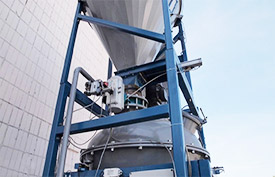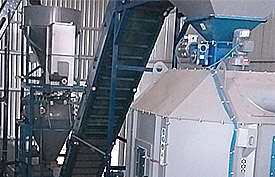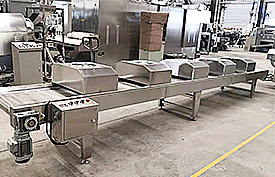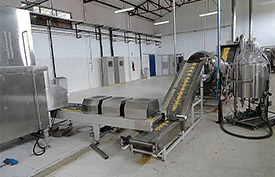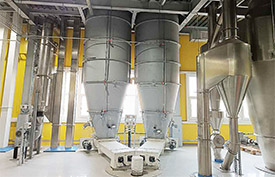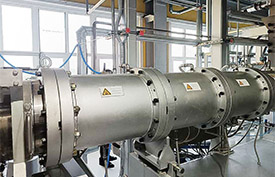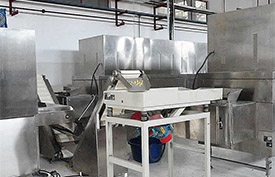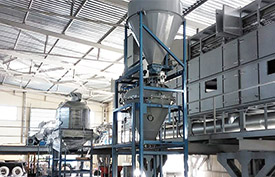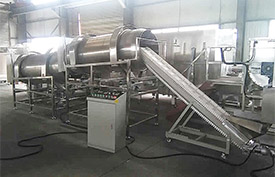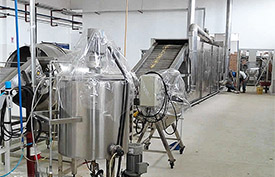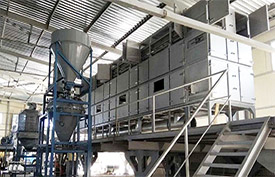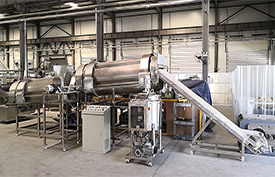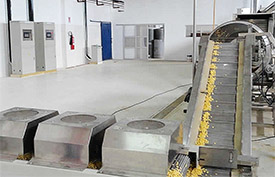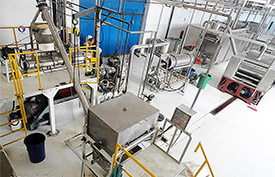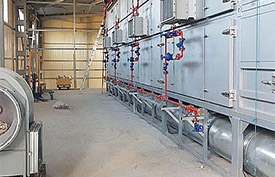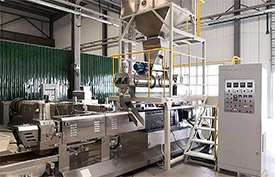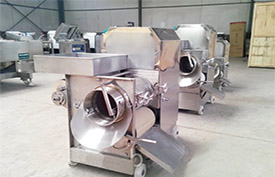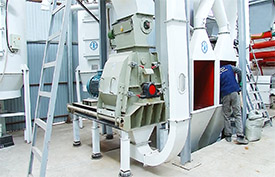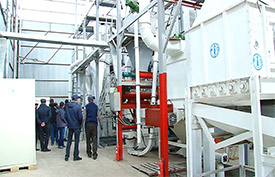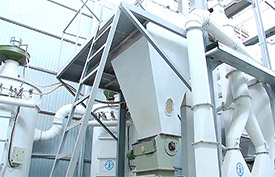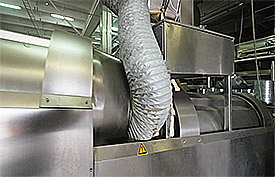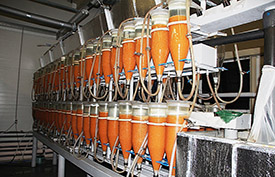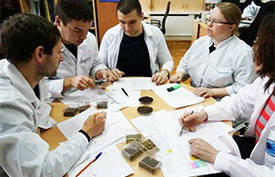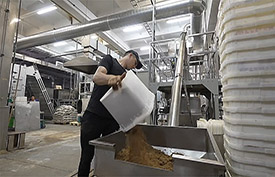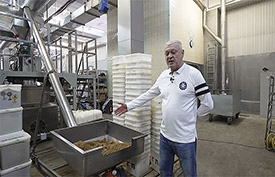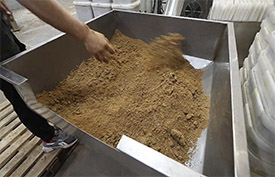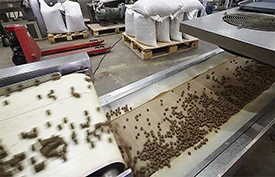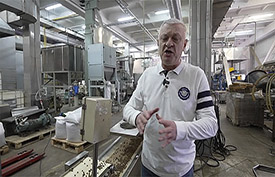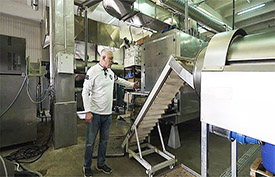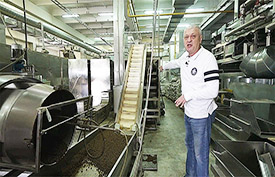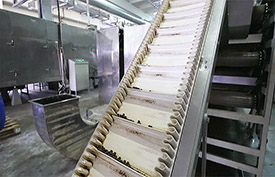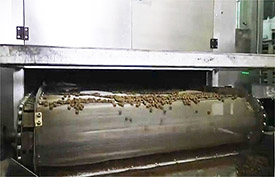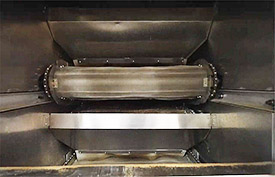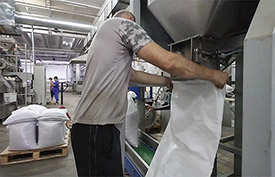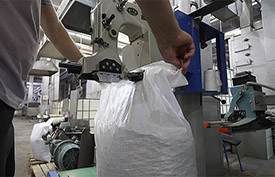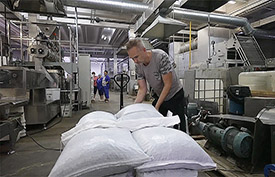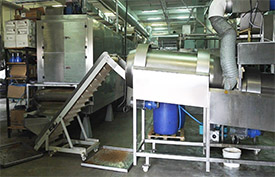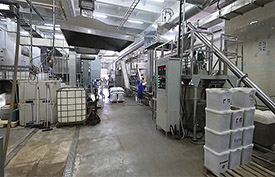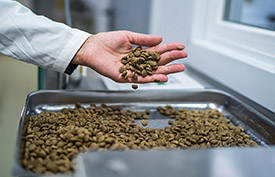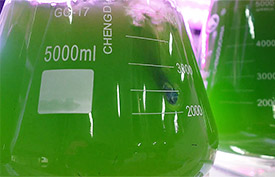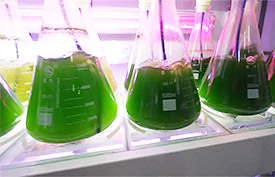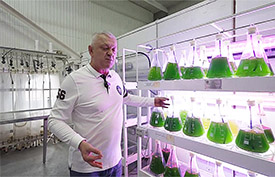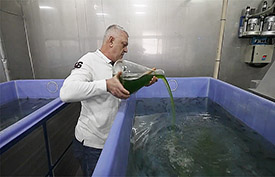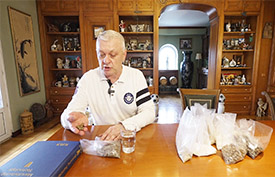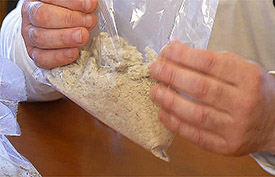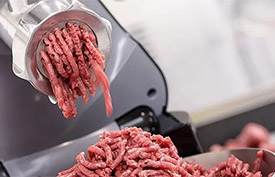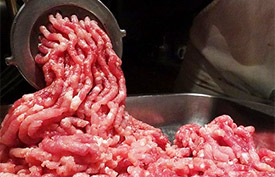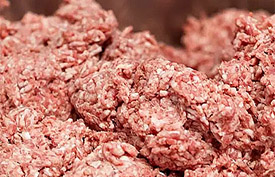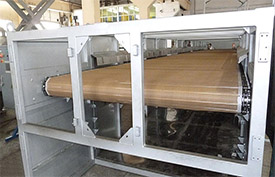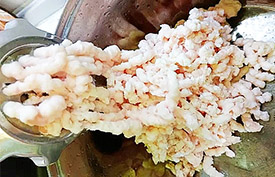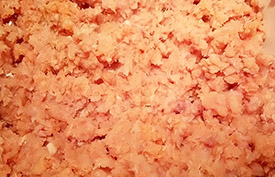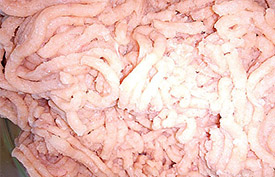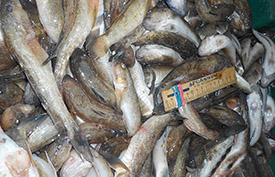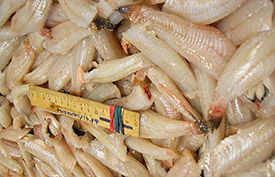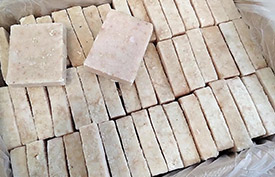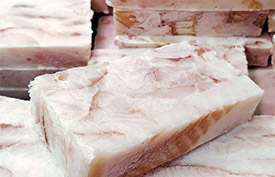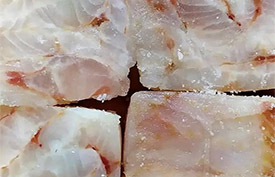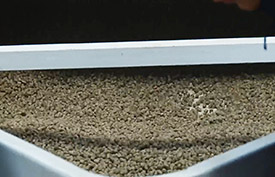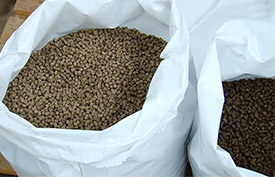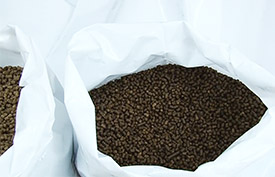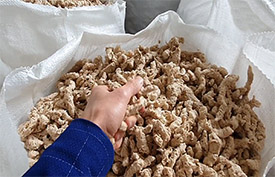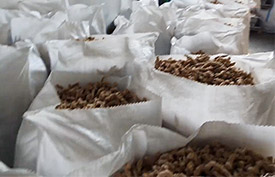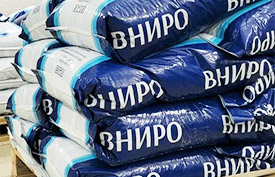The design capacity of the mini plant for the production of feed for fish and crustaceans is up to 5,000 tons per year.
Technology
The technological process of producing extruded feed consists of several stages, including preparation of raw materials, mixing of raw materials, direct extrusion, cutting, drying, adding flavor additives, cooling, and packaging of finished feed.
The productivity of the line depends on the recipe, the quality of raw materials, the installed equipment and its settings.
The main technological stages of extruded feed production
- Preparation of raw materials
The technology for the production of extruded feeds includes the stage of raw material preparation: reception, storage, preliminary grinding and component dosing of raw materials.
- Crushing and mixing of raw materials
The raw material grinding depends largely on the diameter of the extruder die hole. If the hole diameter is 3 mm or more, then at the final stage, the ground raw material should pass through a sieve with holes of 1.2 mm. To ensure a high-quality granule formation process for a die hole diameter of less than 3 mm, the maximum particle size should not exceed 1/3 of the die hole.
The raw material used in extrusion can contain a wide range of ingredients with different particle sizes. It is desirable that the particles be of uniform size and density to prevent self-sorting during mixing and transport to extrusion. Uniform particle size of the raw material prevents the formation of hard, partially non-extruded particles in the granule.
The mixture is fed either directly to the storage bin or through additional crushing in a crusher using transport equipment and a diverter valve. The supply of raw material mixture in the storage bin is automatically replenished.
- Conditioning and extrusion
From the storage bin the mixture enters the operating bin.
The raw material is then fed into the extruder preconditioner for moistening and heating. The preconditioner has two shafts with blades, the rotation of which ensures high-quality mixing and uniform complete penetration of moisture into the raw material ingredients, and promotes plasticization of the raw material particles before extrusion.
In the preconditioner, the mixture is treated with steam and the raw material moisture content increases by 5-7%. The increase in the raw material moisture percentage is achieved by adding water. Steam and water are usually balanced to ensure the mixture temperature at the outlet of the preconditioner is from 70 to 90 ° C. The presence of frequency control of the shaft speed with blades in the preconditioner allows you to control the raw material preparation time, which should be at least 120s.
The prepared mixture from the preconditioner enters the working element of the extruder. In the working element, the raw material is exposed to high temperature, pressure and a high degree of mixing, which determines the final quality of the granule. The profile of the working element screw can be changed by selecting screw elements with different pitch or intermittent turns, which makes it possible to control the residence time and the degree of mixing of the raw material in the corresponding zone.
Adding water to the extruder's working element and the ability to change its configuration allows achieving optimal parameters of the extrusion process: increasing the pressure of the extrudate at the outlet, adjusting the temperature within the range from 125 to 150 ° C and humidity from 23 to 28%. Different configurations of the working element are used for different formulations and granule sizes.
At the outlet of the extruder's working element, a matrix is installed, which performs two main functions:
- the matrix creates resistance to the product flow, resulting in the formation of granule density;
- the holes in the matrix give the granules the required shape at the exit from the extruder.
To separate the continuous layer of extrudate into individual granules, a cutter is used, which consists of several cutting knives. The combination of the rotation speed of the knives and the linear speed of the extrudate output ensures the required granule length.
The area where the granules exit the extruder, as well as the conveyor, are equipped with steam extraction hoods, which are connected to the aspiration system.
After extrusion, the granule is fed into the dryer via a Z-shaped conveyor.
- Drying
The main purpose of drying is to reduce the moisture content of the product granule. For dry foamed extruded products, the final moisture content should be no more than 8% to prevent mold and bacteria growth. The horizontal conveyor type dryer is the most common drying equipment for most extrusion lines.
The drying process is as follows:
- the granules are laid in an even layer on the dryer flooring belt and move at a constant speed;
- cold air is heated by steam heaters;
- the heating agent (heated air) passes through the product layer at a speed of 0.8 to 1 m/s at a coolant temperature of 60 to 100°C;
- circulation of the coolant in the volume of the dryer ensures the transfer of thermal energy to the granules, due to which moisture evaporates from the product and is released into the environment;
- due to the recirculation valve, part of the heat agent emitted into the environment is mixed with fresh air, which is supplied to the heater, provides savings in heat energy and significantly reduces the cost of the drying process. After the drying process, the granules are fed to the vibrating screen by transport equipment. The vibrating screen is designed to separate conditioned granules from substandard ones and spillage.
- Applying fat and cooling
To improve the taste, the granules are fed to a liquid additive application unit. Liquid fat and other additives (flavors, vitamins, etc.) are applied to the granule. Before applying the fat, the granules are not cooled, but are supplied hot (about 80 ° C) and dry (about 8% humidity). This is due to the fact that a warm product absorbs additives better. Liquid fats and additives are applied in a coater by spraying liquid and dry powder over the product. In the liquid fat tanks, it is heated to 60 ° C, which is recommended for application.
Two types of equipment for applying liquid fat and additives: vacuum or rotary coaters. The configuration depends on the characteristics of the feed being produced.
The rotary coater operates on the principle of passing the dry product through a torch of liquid fat created by a rotating disk. A mixer is used to absorb the liquid additive into the granule. The process occurs at atmospheric pressure.
The vacuum coater is designed to apply liquid additives to low-density granules. Compared to the rotary coater, it allows for up to 40% fat to be added to the granule by infusing it into the cell structure. Vacuum infusion delivers fat components to all air pores inside the extruded product, while atmospheric infusion provides only a surface coating.
Vacuum or rotary coaters are supplied complete with a liquid additive preparation system.
To use solid fat as an ingredient for coating on granules, an additional option is required, which consists of the presence of a fat melter in the line. After the fat is applied, the granules are fed to a counter-current cooler using a conveyor. There they are cooled to room temperature and then fed to a vibrating screen to separate the fine fraction from the finished product before packaging.
The main advantage of the counter-flow cooler over other types is minimal damage to the granule and high productivity.
- Packaging
After cooling, the granules are fed into the operating bin using transport equipment. The granules are packed into bags and sacks using a packaging machine.
Vacuum sprayer
In the KAHL vacuum sprayer, fish pellets are enriched with fats and liquids. The operator can monitor and influence the process flow during vacuum spraying. Depending on the properties of the extrudate or the recipe, the parameters can be adapted. This applies in particular to the important steps of liquid dosing, vacuum interruption, process sequence and the rotational speed of the additive sprayer. This allows the degree of liquid saturation in the product, the formation of fine particles and the throughput to be optimally adjusted.
Process:
- We work on the most modern Danish and German equipment, which allows us to use the most advanced technologies in feed production.
- The use of a vacuum deposition system allows for the introduction of large quantities of fish oil into the granules.
- Our feed does not dust, the granules are stable in water, which is very important for farms with RAS.
Advantages of using extrusion:
Mechanical grinding:The resulting fine structure of the feed is highly desirable for optimal digestion. Expansion at the outlet of the extruder nozzle leads to the destruction of the internal structure of the material, facilitating its digestion, and also to an increase in the surface area of the feed, which accelerates the absorption of nutrients in the digestive tract.
Destruction of the structure (denaturation) of proteins:Short-term heating above 100°C with simultaneous exposure to high pressure in the extruder very effectively changes the structure of proteins (folding, denaturation), thereby increasing the energy value of the feed.
Deactivation of unwanted enzymes:
Radical reduction of antinutrients and natural toxins:Extrusion very effectively neutralizes a number of antinutrients. For example, soybeans show a significant decrease in urease activity after extrusion. In feed for monogastric animals, a very positive aspect is the decrease in the content of trypsin inhibitor.
Sterilization:The temperature and pressure in the extruder reliably destroy all bacteria, fungi and other unwanted microorganisms and pests. The growth of mold and the release of mycotoxins stop, which allows for an extended shelf life.
Gelatinization of starch:Starch is a very common and important element of feed. During the extrusion process, complex starchy carbohydrates and sugars are converted into simple ones, which simplifies the digestibility of the feed.
Manufactured products:
- Food for young crustaceans.
- Feed for commercial crustaceans.
- Food for growing juvenile catfish.
- Floating feed for growing commercial sharptooth catfish.
- Food for sturgeon producers, for spawning and caviar.
- Production feed for sturgeon fish.
- Food for yearlings, yearlings of salmon fish and trout.
- Fry food for salmon and trout.
- Feed for commercial salmon and trout.
Animal Components
The biological value of animal feeds is the high content of digestible protein. Such feeds are very nutritious and contain essential acids, minerals and vitamins.
Characteristics of animal feed:
- Fish meal
- Crab flour
- Krill flour
- Meat meal
- Minced fish
- Minced meat
- Meat and bone meal
- Meat and feather meal
- Bone meal
- Blood meal
- Silkworm pupa
- Dry skim milk
Components of plant origin
Among the feeds with plant composition, there are components with a high content of starch, fat and protein.
Starch-rich ingredients:
- Wheat.
- Barley.
- Rye.
- Oats.
- Corn.
- Dry ground leaves (oak, beech, almond, walnut).
Components rich in protein and fat:
- Peas.
- Cake and meal from sunflower, flax, rapeseed and soybeans.
- Lupine grains.
- Seaweed flour.
- Herbal flour.
- Pine flour.
Fat additives:
- Fish oil.
- Krill oil.
- L-Lysine sulfate.
- Feed gluten.
- Phosphatide and vegetable oils (sunflower, soybean, corn and flaxseed).
